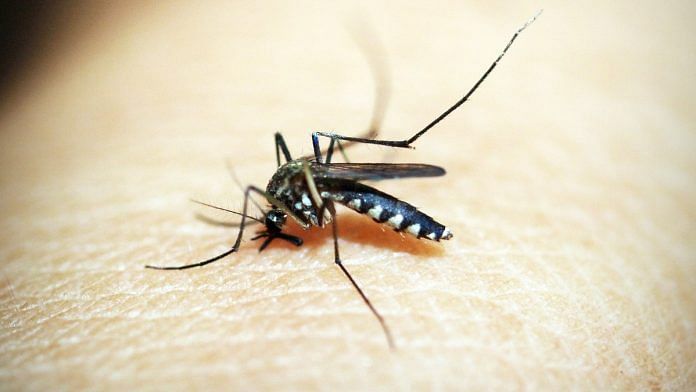The US has just issued a health alert after cases of locally-transmitted malaria were identified in the states of Florida and Texas. Malaria is typically viewed as a disease affecting tropical countries and it is the first time in 20 years the disease has been spread locally in the US.
Although the risk of contracting the disease in the US remains very low, with only five cases confirmed so far in total, there is a growing concern that mosquito-borne diseases like malaria may become more common as the climate crisis raises temperatures globally.
Data shows, for example, that a mosquito species known to be a vector of the chikungunya and dengue viruses is establishing itself further north and west into Europe, according to the European Centre for Disease Prevention and Control (ECDC). Another species that can spread dengue, yellow fever, chikungunya, Zika and West Nile viruses is now established in Cyprus.
So what do we know about the influence of climate change on the spread of malaria and other mosquito-borne diseases? And is there anything we can do to prepare for them?

The situation has not worsened when compared to 2020 but we are far from achieving global goals: thousands of lives are still lost to malaria.
The malaria burden
Almost 250 million people are infected with malaria each year – and it kills nearly 620,000 people. Despite being preventable and curable, it is one of the deadiest diseases affecting humans. Africa bears by far the highest burden – the region is home to 95% of cases and 96% of deaths.
The US cases mark the first time since 2003 that the disease has been acquired locally and all the patients have all received treatment and are improving. The particular mosquito species concerned can be found in many regions of the country, and while it is extremely unlikely you will catch malaria in these parts, the US Centers for Disease Control and Prevention (CDC) notes the risk is higher where the local climate allows the mosquito to survive for long periods.
In Europe, warmer and longer summers are also contributing to the spread of mosquitoes, says the ECDC. Ten years ago, the Aedes albopictus mosquito was established in eight countries in the EU, with 114 regions being affected. Now, the mosquito is established in 13 countries and 337 regions.

Warmer weather is contributing to the spread of mosquitoes around Europe. Image: ECDC
How is malaria spread?
Malaria is spread through the bite of a female anopheline mosquito that has been infected with a malaria-causing parasite. Mosquitoes can pick up the parasite by feeding on malaria-infected individuals. Rarely, malaria can also be transmitted from mother to baby at birth, and through blood transfusion or organ transplants.
Prior to this latest cluster of infections, virtually all cases of malaria in the US were a result of travellers picking up the disease. Prior to the pandemic, there were around 2,000 cases of malaria in the country annually, of which 300 were severe and 5-10 people died, according to the CDC.
What does climate change have to do with it?
As the climate warms it gives the mosquito a longer period to live and breed, as well as potentially expanding its habitat. An extra 4.7 billion people might be at risk of malaria or dengue by 2070 as the “epidemic belt” of the diseases expands, a 2021 study found.
The study also notes that the expansion of diseases into new regions brings the risk of outbreaks in populations whose immune systems have not previously been exposed to them. Alongside this, healthcare systems may not be prepared.
However, the spread of diseases like malaria is complex and depends on factors including population dynamics, drug and insecticide resistance, and human activities that affect ecology and habitats such as deforestation or irrigation practices.
What can public health systems do to prepare for diseases linked to climate change?
Malaria was historically endemic in Europe but was eliminated in 1975 because of better socioeconomic conditions, access to healthcare, irrigation and farming practices.
Malaria can be prevented by avoiding mosquito bites through the use of mosquito nets and protective clothing, as well as chemical repellents. Medicines can also prevent infection.
Community awareness of mosquito control is part of the solution and can help communities implement prevention measures, such as getting rid of standing water where mosquitoes like to breed.
Two other core interventions to control mosquito populations include insecticide-treated nets and indoor residual spraying. However, there has been a concerning rise in resistance to these chemical options among some mosquito species.
Early diagnosis and treatment is key to limiting disease severity and spread, and the World Health Organization recommends that all suspected cases of malaria are tested. Malaria infections always require treatment.
In 2021, 35 countries reported 1,000 or fewer indigenous cases of malaria, according to WHO figures. Since 2015 nine countries have been certified by the WHO as being malaria-free (achieving 3 consecutive years of zero indigenous cases). These are Maldives, Sri Lanka, Kyrgyzstan, Paraguay, Uzbekistan, Argentina, Algeria, China and El Salvador.
The organization’s strategy to deal with malaria includes targets to reduce malaria case incidence by at least 90% by 2030, reduce malaria mortality rates by at least 90% by 2030, eliminate malaria in at least 35 countries by 2030, and prevent a resurgence of malaria in all malaria-free countries.
Disease prevention and detection will become increasingly important as the impacts of the climate crisis intensify, the World Economic Forum notes in its June 2023 report Scaling Smart Solutions with AI in Health. Artificial intelligence technologies can help speed up and improve predictive, monitoring and diagnostic processes.
The article was originally published in the World Economic Forum
Also read: Upendranath Brahmachari—forgotten Bengali scientist behind kala-azar cure got 2 Nobel nods



